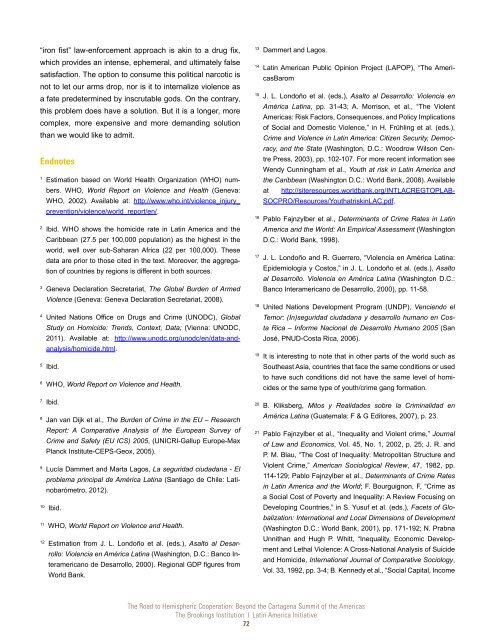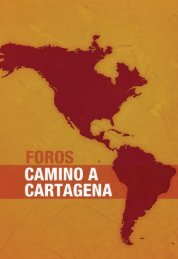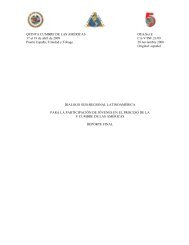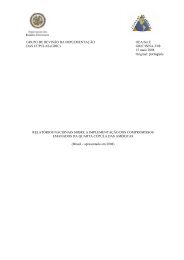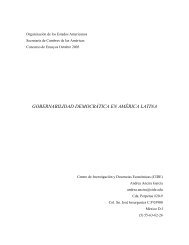The Road to Hemispheric Cooperation: Beyond the Cartagena
The Road to Hemispheric Cooperation: Beyond the Cartagena
The Road to Hemispheric Cooperation: Beyond the Cartagena
Create successful ePaper yourself
Turn your PDF publications into a flip-book with our unique Google optimized e-Paper software.
“iron fist” law-enforcement approach is akin <strong>to</strong> a drug fix,<br />
which provides an intense, ephemeral, and ultimately false<br />
satisfaction. <strong>The</strong> option <strong>to</strong> consume this political narcotic is<br />
not <strong>to</strong> let our arms drop, nor is it <strong>to</strong> internalize violence as<br />
a fate predetermined by inscrutable gods. On <strong>the</strong> contrary,<br />
this problem does have a solution. But it is a longer, more<br />
complex, more expensive and more demanding solution<br />
than we would like <strong>to</strong> admit.<br />
Endnotes<br />
1 Estimation based on World Health Organization (WHO) numbers.<br />
WHO, World Report on Violence and Health (Geneva:<br />
WHO, 2002). Available at: http://www.who.int/violence_injury_<br />
prevention/violence/world_report/en/.<br />
2 Ibid. WHO shows <strong>the</strong> homicide rate in Latin America and <strong>the</strong><br />
Caribbean (27.5 per 100,000 population) as <strong>the</strong> highest in <strong>the</strong><br />
world, well over sub-Saharan Africa (22 per 100,000). <strong>The</strong>se<br />
data are prior <strong>to</strong> those cited in <strong>the</strong> text. Moreover, <strong>the</strong> aggregation<br />
of countries by regions is different in both sources.<br />
3 Geneva Declaration Secretariat, <strong>The</strong> Global Burden of Armed<br />
Violence (Geneva: Geneva Declaration Secretariat, 2008).<br />
4 United Nations Office on Drugs and Crime (UNODC), Global<br />
Study on Homicide: Trends, Context, Data; (Vienna: UNODC,<br />
2011). Available at: http://www.unodc.org/unodc/en/data-andanalysis/homicide.html.<br />
5 Ibid.<br />
6 WHO, World Report on Violence and Health.<br />
7 Ibid.<br />
8 Jan van Dijk et al., <strong>The</strong> Burden of Crime in <strong>the</strong> EU – Research<br />
Report: A Comparative Analysis of <strong>the</strong> European Survey of<br />
Crime and Safety (EU ICS) 2005, (UNICRI-Gallup Europe-Max<br />
Planck Institute-CEPS-Geox, 2005).<br />
9 Lucía Dammert and Marta Lagos, La seguridad ciudadana - El<br />
problema principal de América Latina (Santiago de Chile: Latinobarómetro,<br />
2012).<br />
10 Ibid.<br />
11 WHO, World Report on Violence and Health.<br />
12 Estimation from J. L. Londoño et al. (eds.), Asal<strong>to</strong> al Desarrollo:<br />
Violencia en América Latina (Washing<strong>to</strong>n, D.C.: Banco Interamericano<br />
de Desarrollo, 2000). Regional GDP figures from<br />
World Bank.<br />
13 Dammert and Lagos.<br />
14 Latin American Public Opinion Project (LAPOP), “<strong>The</strong> Ameri-<br />
casBarom<br />
15 J. L. Londoño et al. (eds.), Asal<strong>to</strong> al Desarrollo: Violencia en<br />
América Latina, pp. 31-43; A. Morrison, et al., “<strong>The</strong> Violent<br />
Americas: Risk Fac<strong>to</strong>rs, Consequences, and Policy Implications<br />
of Social and Domestic Violence,” in H. Frühling et al. (eds.),<br />
Crime and Violence in Latin America: Citizen Security, Democracy,<br />
and <strong>the</strong> State (Washing<strong>to</strong>n, D.C.: Woodrow Wilson Centre<br />
Press, 2003), pp. 102-107. For more recent information see<br />
Wendy Cunningham et al., Youth at risk in Latin America and<br />
<strong>the</strong> Caribbean (Washing<strong>to</strong>n D.C.: World Bank, 2008). Available<br />
at http://siteresources.worldbank.org/INTLACREGTOPLAB-<br />
SOCPRO/Resources/YouthatriskinLAC.pdf.<br />
16 Pablo Fajnzylber et al., Determinants of Crime Rates in Latin<br />
America and <strong>the</strong> World: An Empirical Assessment (Washing<strong>to</strong>n<br />
D.C.: World Bank, 1998).<br />
17 J. L. Londoño and R. Guerrero, “Violencia en América Latina:<br />
Epidemiología y Cos<strong>to</strong>s,” in J. L. Londoño et al. (eds.), Asal<strong>to</strong><br />
al Desarrollo. Violencia en América Latina (Washing<strong>to</strong>n D.C.:<br />
Banco Interamericano de Desarrollo, 2000), pp. 11-58.<br />
18 United Nations Development Program (UNDP), Venciendo el<br />
Temor: (In)seguridad ciudadana y desarrollo humano en Costa<br />
Rica – Informe Nacional de Desarrollo Humano 2005 (San<br />
José, PNUD-Costa Rica, 2006).<br />
19 It is interesting <strong>to</strong> note that in o<strong>the</strong>r parts of <strong>the</strong> world such as<br />
Sou<strong>the</strong>ast Asia, countries that face <strong>the</strong> same conditions or used<br />
<strong>to</strong> have such conditions did not have <strong>the</strong> same level of homicides<br />
or <strong>the</strong> same type of youth/crime gang formation.<br />
20 B. Kliksberg, Mi<strong>to</strong>s y Realidades sobre la Criminalidad en<br />
América Latina (Guatemala: F & G Edi<strong>to</strong>res, 2007), p. 23.<br />
21 Pablo Fajnzylber et al., “Inequality and Violent crime,” Journal<br />
of Law and Economics, Vol. 45, No. 1, 2002, p. 25; J. R. and<br />
P. M. Blau, “<strong>The</strong> Cost of Inequality: Metropolitan Structure and<br />
Violent Crime,” American Sociological Review, 47, 1982, pp.<br />
114-129; Pablo Fajnzylber et al., Determinants of Crime Rates<br />
in Latin America and <strong>the</strong> World; F. Bourguignon, F, “Crime as<br />
a Social Cost of Poverty and Inequality: A Review Focusing on<br />
Developing Countries,” in S. Yusuf et al. (eds.), Facets of Globalization:<br />
International and Local Dimensions of Development<br />
(Washing<strong>to</strong>n D.C.: World Bank, 2001), pp. 171-192; N. Prabna<br />
Unnithan and Hugh P. Whitt, “Inequality, Economic Development<br />
and Lethal Violence: A Cross-National Analysis of Suicide<br />
and Homicide, International Journal of Comparative Sociology,<br />
Vol. 33, 1992, pp. 3-4; B. Kennedy et al., “Social Capital, Income<br />
<strong>The</strong> <strong>Road</strong> <strong>to</strong> <strong>Hemispheric</strong> <strong>Cooperation</strong>: <strong>Beyond</strong> <strong>the</strong> <strong>Cartagena</strong> Summit of <strong>the</strong> Americas<br />
<strong>The</strong> Brookings Institution ❘ Latin America Initiative<br />
72


